
The FBI reported Monday that 1,197,704 violent crimes were committed in 2015, up 3.9% from 2014. While the increase is discouraging, it is by no means a crime wave. Some areas have serious crime problems, but there are a number of U.S. cities where violence is a rare occurrence.
24/7 Wall St. reviewed violent crime rates in major U.S. cities from the FBI’s 2015 Uniform Crime Report. Violent crime includes all offenses involving force or threat of force and are broken into four categories: murder and nonnegligent manslaughter, rape, robbery, and aggravated assault. For every 100,000 U.S. residents, 373 violent crimes were committed in 2015.
[in-text-ad]
Cary, North Carolina is the safest city in the nation with just 51 reported violent crimes per 100,000 city residents. By contrast, St. Louis, Missouri, leads the nation with 1,817 violent crimes per 100,000 residents.
Click here to see the safest cities in America.
Click here to see the most dangerous cities in America.
Relatively crime-free cities can be found just a few hundred miles from some of the most violent places in the country. California is home to cities such as Irvine, Murrieta, and Sunnyvale, which have among the 10 lowest violent crime rates of all U.S. major cities. California is also home to some of the most violent cities in the country, including Oakland, which is just 40 miles from Sunnyvale.
In an interview with 24/7 Wall St., Nancy La Vigne, director of the Justice Policy Center at nonprofit economic and social policy research organization the Urban Institute, noted the highly localized nature of violence in the United States. “We see no connection between state policies and where these [crime] trends are up or down,” La Vigne said.
Because many diverse and complex factors can affect violence in a community, it is very difficult to predict and address violent crime. For example, some cities attempt to curb gang violence by increasing enforcement. These efforts, however, are usually unsuccessful, “if you don’t look at issues around structural inequality and reasons why kids may be compelled to join gangs to begin with,” La Vigne explained.
For example, in many cases, the reason for the lack of violence is the presence of more lawful activities, including — La Vigne noted — employment opportunities. The unemployment rate is below the national rate of 5.3% in 20 of the 25 cities with the lowest violent crime rates.
Several other social and economic factors have been tied to low violent crime. The vast majority of cities with the lowest violent crime rates tend to also report very high incomes, low poverty, and high educational attainment.
To identify the 25 safest U.S. cities, 24/7 Wall St. reviewed violent crime rates in cities with at least 100,000 people from the FBI’s 2015 Uniform Crime Report released Monday. The total number and rates of murder, non negligent manslaughter, rape, robbery, and aggravated assault, which are included in the violent crime rate, as well as burglaries, larceny, motor vehicle theft, and arson — all classified as property crime — also came from the FBI’s report. We also considered these data for each year from 2011 through 2015. Annual unemployment rates for 2015 came from the Bureau of Labor Statistics (BLS). Median household income, poverty rates, the percentage of adults with at least a bachelor’s degree, population, and the percentage of adults with at least a high school diploma came from the U.S. Census Bureau’s American Community Survey (ACS).
These are America’s 25 safest cities.
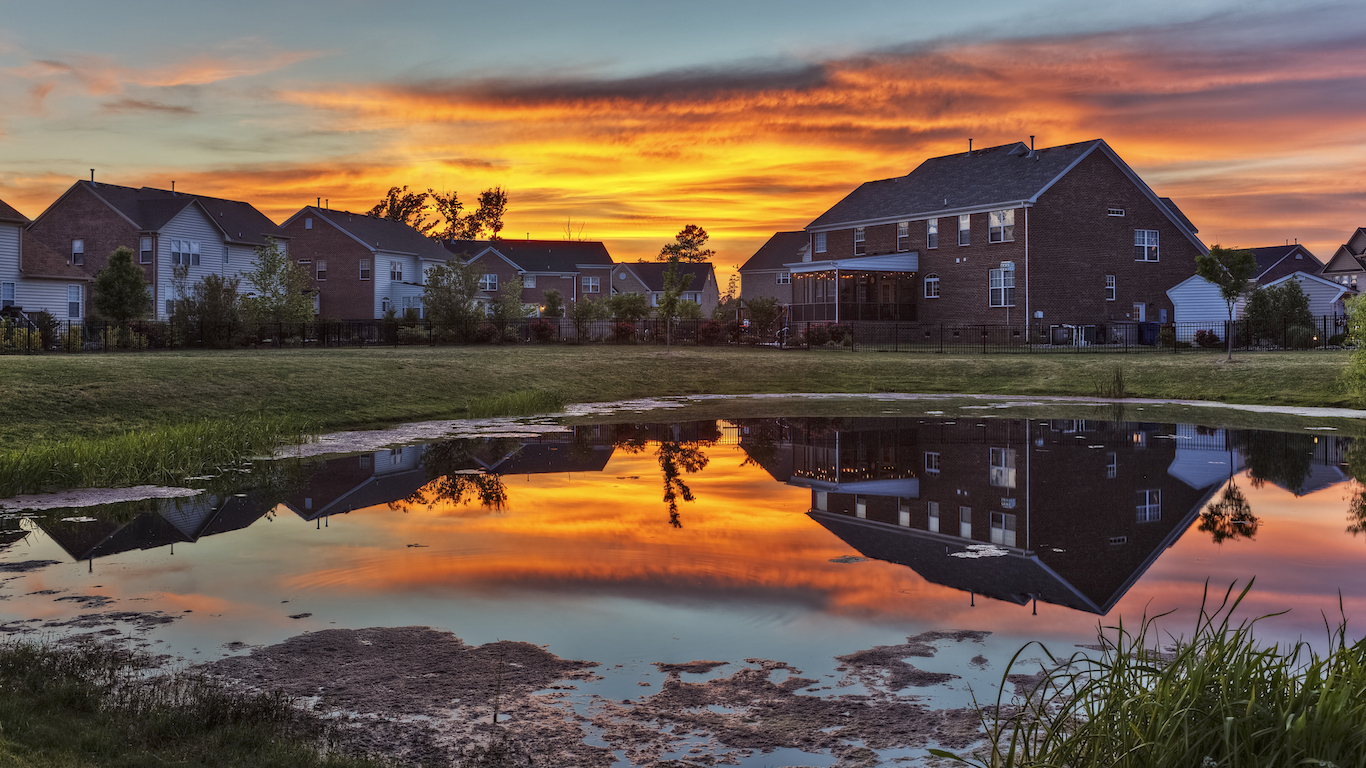
25. Virginia Beach, Virginia
> Violent crimes per 100,000: 138.3
> 2015 murders: 19
> Poverty rate: 8.3%
> Unemployment rate: 4.3%
There were 138 violent crimes per 100,000 residents in Virginia Beach in 2015, roughly one-third the national violent crime rate. Of the 626 violent crimes that were reported in the city that year, there were 234 aggravated assault incidents, 270 robberies, 103 rapes, and 19 murders. The number of murders reported in Virginia Beach is exceptionally high compared with other relatively safe cities, most of which reported no more than two murders last year.
[in-text-ad]
Crime tends to be less prevalent in more affluent areas. Virginia Beach is one such area, with a poverty rate of just 8.3%, or nearly half the national poverty rate of 15.6%.
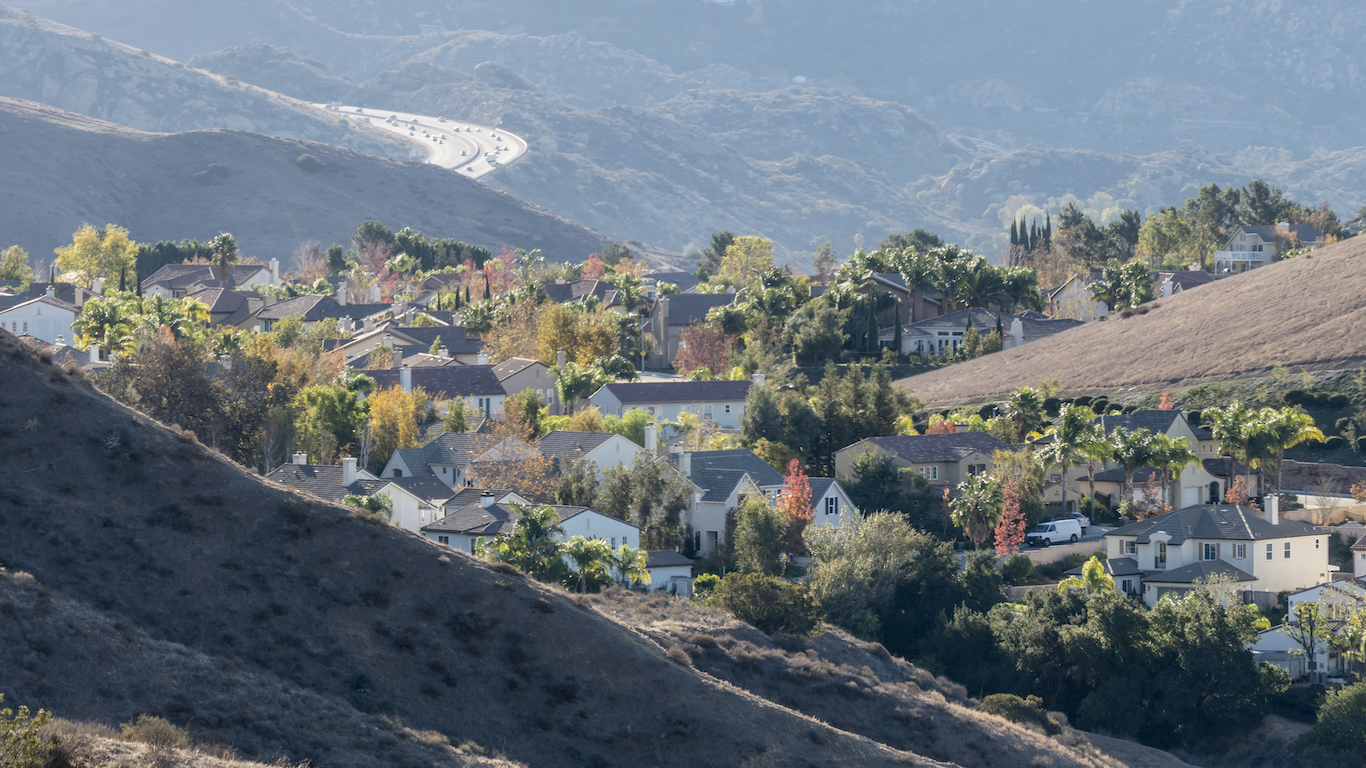
24. Simi Valley, California
> Violent crimes per 100,000: 136.5
> 2015 murders: 1
> Poverty rate: 6.6%
> Unemployment rate: 5.0%
Like residents of most of the nation’s safest cities, Simi Valley residents are well-off financially. The typical household earns $89,595 a year, the 13th highest median household income of major U.S. cities and considerably higher than the national median household income of $53,482. Low violent crime levels are tied to the affluence of a city’s population. In these cities there are often more lawful activities — employment opportunities, for example — available to residents.
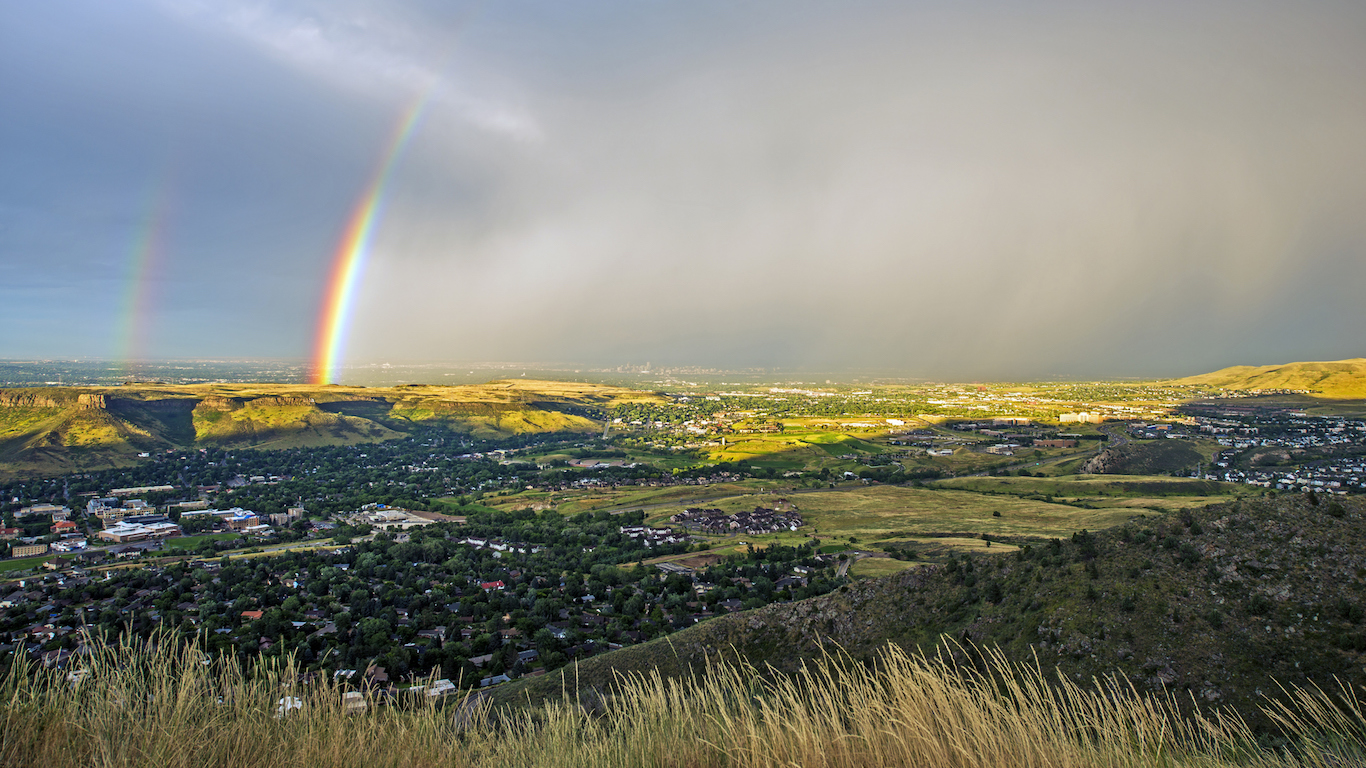
23. Arvada, Colorado
> Violent crimes per 100,000: 135.2
> 2015 murders: 2
> Poverty rate: 8.4%
> Unemployment rate: 3.6%
While there is no evidence that unemployed individuals are more likely to commit violence than individuals who are employed, cities with low crime rates tend to also have relatively healthy job markets. Arvada is one such city — just 3.6% of the workforce is unemployed, well below the national annual rate of 5.3%.

22. Provo, Utah
> Violent crimes per 100,000: 132.7
> 2015 murders: 0
> Poverty rate: 30.1%
> Unemployment rate: 3.0%
The FBI did not document a single murder or nonnegligent manslaughter in Provo last year, one of only a handful of major U.S. cities where such killings were practically nonexistent. As is almost always the case, aggravated assaults made up the majority of violent incidents in Provo. At 67 incidents per 100,000, Provo’s aggravated assault rate is less than a third of the national rate of 237 aggravated assaults per 100,000 Americans.
Compared with other relatively safe cities, Provo’s poverty rate is exceptionally high. At over 30% it is close to double the national poverty rate.
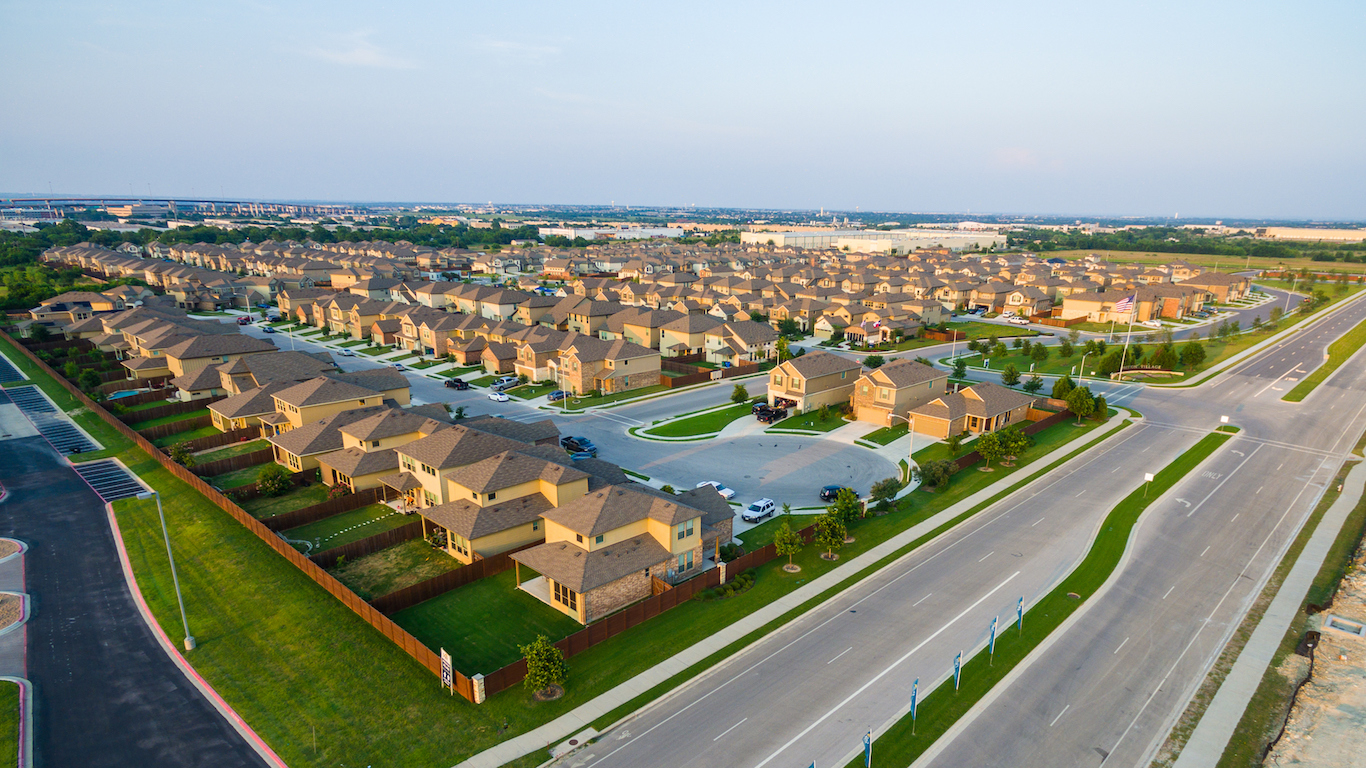
21. Round Rock, Texas
> Violent crimes per 100,000: 131.9
> 2015 murders: 1
> Poverty rate: 9.8%
> Unemployment rate: 3.2%
With a violent crime rate of 132 incidents per 100,000, well under half the national rate of 373 per 100,000, Round Rock is one of the safest cities in the United States. However, violent crime rose by 33.0% over the five years through 2015, among the largest spikes of any major U.S. city. Specifically, there was a 61.2% surge in the number of aggravated assaults, the eighth largest such increase. Round Rock’s dramatic population growth over that time of 13.7% can partly explain the increase in the number of crimes. Still, crime levels remain low, likely explained by the same economic factors that attract residents to the city. Fewer than 10% of residents live in poverty, and just 3.2% of the workforce is unemployed, each among the lowest such percentages of any major city.
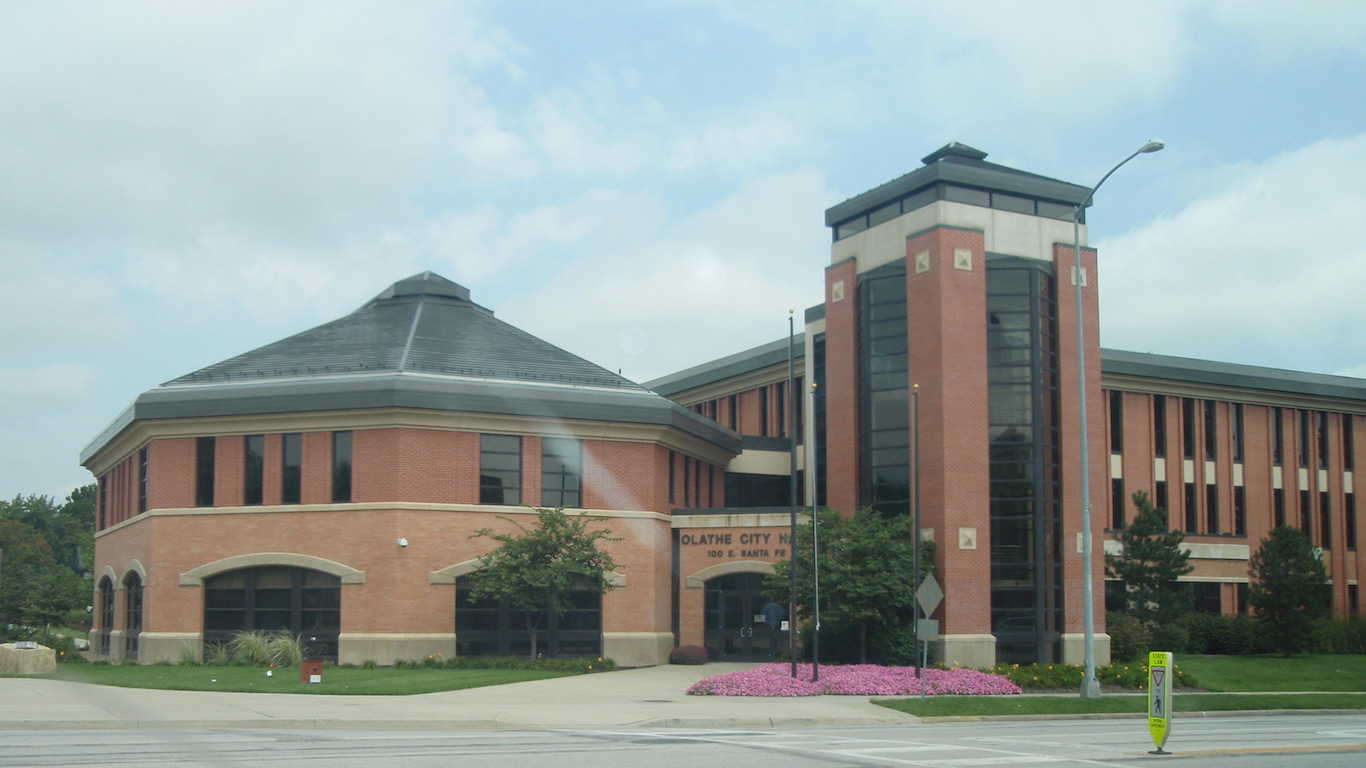
20. Olathe, Kansas
> Violent crimes per 100,000: 131.3
> 2015 murders: 3
> Poverty rate: 7.4%
> Unemployment rate: 3.3%
Crime is often less prevalent in cities with low poverty and unemployment, which could help explain why Olathe is one of the safest cities in the country. Just 7.4% of Olathe residents live in poverty and just 3.3% of workers are unemployed, far lower than the national poverty and unemployment rates of 15.6% and 5.3%, respectively. While Olathe is one of the safest cities, crime is on the rise. The number of violent crimes rose by 75.2% between in 2015, the sharpest increase of any U.S. city.
[in-text-ad]
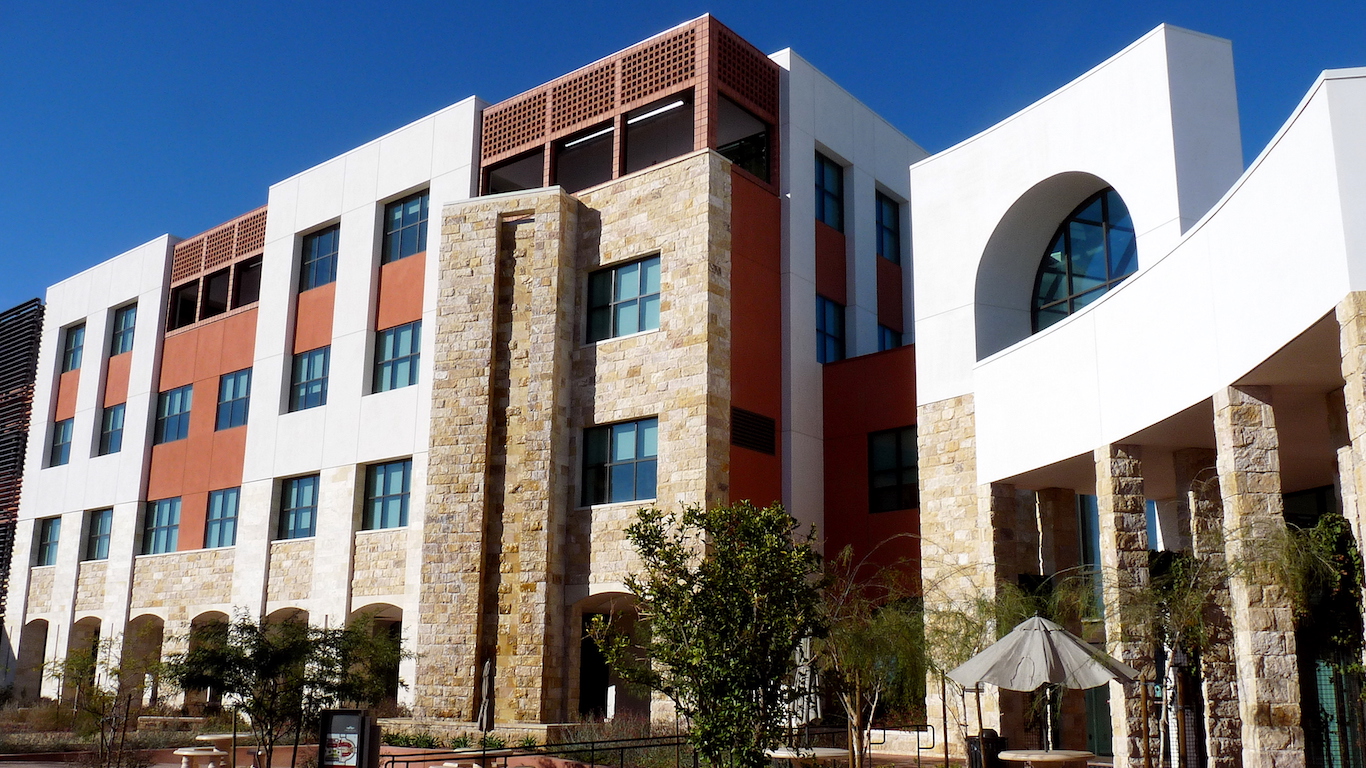
19. Surprise, Arizona
> Violent crimes per 100,000: 130.7
> 2015 murders: 2
> Poverty rate: 11.0%
> Unemployment rate: 5.6%
Just 131 violent crimes were reported per 100,000 Surprise residents in 2015, far fewer than the national rate of 373 violent crimes per 100,000 Americans. While Surprise remains one of the safest cities in the country, 2015 was far more dangerous than in the previous year. The 22.6% jump in the number of violent crimes, one of the sharpest increases of any U.S. city, was driven by greater numbers of rapes and aggravated assaults last year.

18. Corona, California
> Violent crimes per 100,000: 129.6
> 2015 murders: 5
> Poverty rate: 11.3%
> Unemployment rate: 5.2%
There were just 130 violent crimes per 100,000 Corona residents in 2015, much lower than the national crime rate of 373 per 100,000. While Corona is one of the safest cities in the country, crime has been on the rise. The number of violent crimes reported in the city rose by 24% last year, one of the sharpest increases of any major U.S. city. In response to the spike in crime, the Corona police department initiated an investigation into local gang activity earlier this year. In a single sweep of the city, the police department made 52 arrests and seized an estimated $1.6 million worth of drugs.

17. Santa Clara, California
> Violent crimes per 100,000: 126.3
> 2015 murders: 1
> Poverty rate: 9.0%
> Unemployment rate: 3.7%
Just 126 violent crimes per 100,000 residents were reported in Santa Clara in 2015, among the lowest of any city in the country. Violent crime tends to be less common in wealthier areas, and the affluence of Santa Clara’s population may partially explain the city’s low crime rate. The typical household in Santa Clara earns $93,840 a year, the seventh highest median income of any large U.S. city. Also, Santa Clara’s low unemployment rate, at 3.7%, reflects a healthy job market. In such economic conditions, residents are less likely to turn to criminal activities out of necessity.
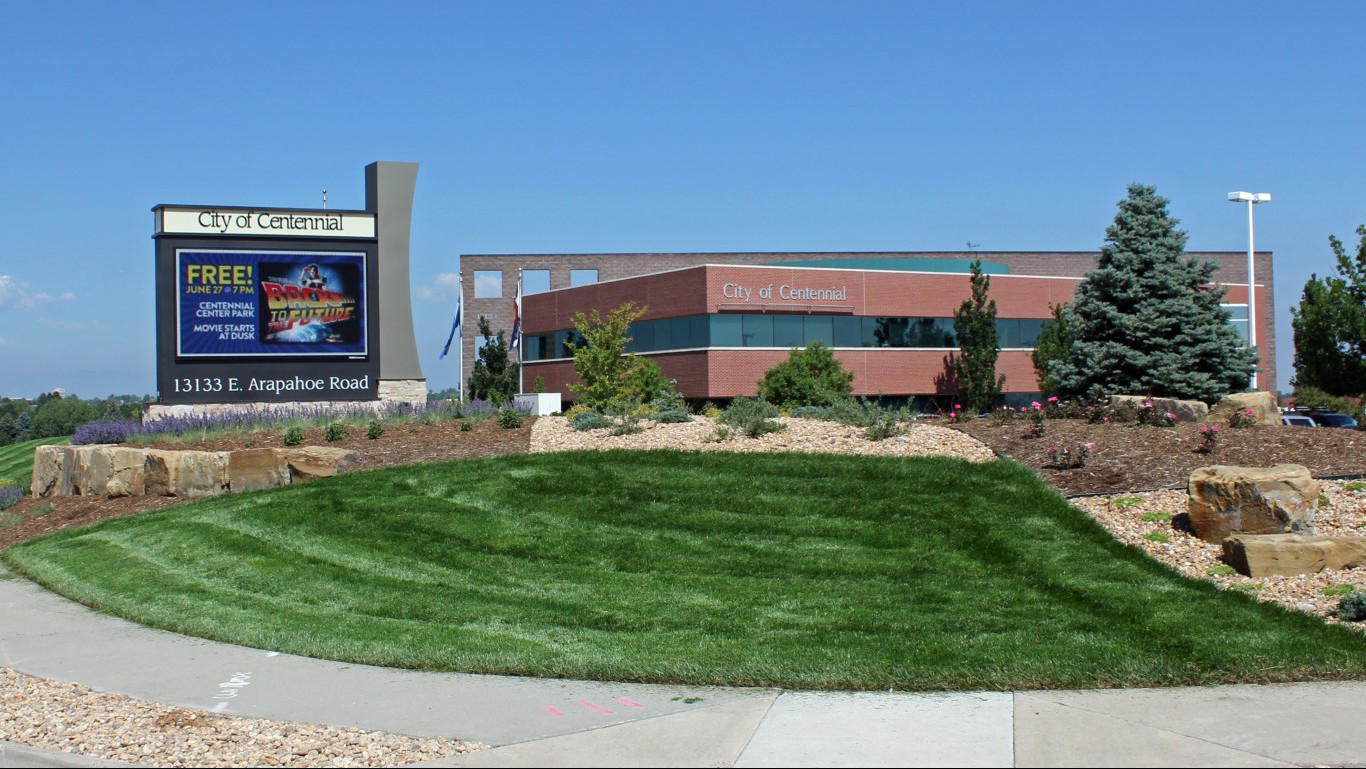
16. Centennial, Colorado
> Violent crimes per 100,000: 125.9
> 2015 murders: 1
> Poverty rate: 5.2%
> Unemployment rate: 3.6%
Crime tends to be less prevalent in areas with low poverty and low unemployment, as fewer crimes are committed out of financial necessity and more legal economic opportunities are available, for example. In Centennial, just 5.2% of residents live in poverty, and 3.6% of workers are unemployed, far lower than the national poverty and unemployment rates. Also, 97.4% of Centennial adults have at least a high school diploma, the largest share in the country. The high educational attainment rate likely helps keep unemployment low and therefore help keep crime levels also low.

15. Orange, California
> Violent crimes per 100,000: 122.4
> 2015 murders: 7
> Poverty rate: 12.6%
> Unemployment rate: 4.2%
While Orange is one of the safest cities in the country, crime there is on the rise. Even as the population fell, there was a 21.1% increase in the number of violent crimes between in 2015, one of the sharpest spikes in crime nationwide. In 2014, California passed a law that reduced prison sentences for certain drug offenders. The Orange County Sheriff’s Department attributed the crime increase to the law, claiming it would lead to potential repeat offenders returning from prison sooner. The number of burglaries in Orange surged by 43.4%, the fourth most of any city.
[in-text-ad]
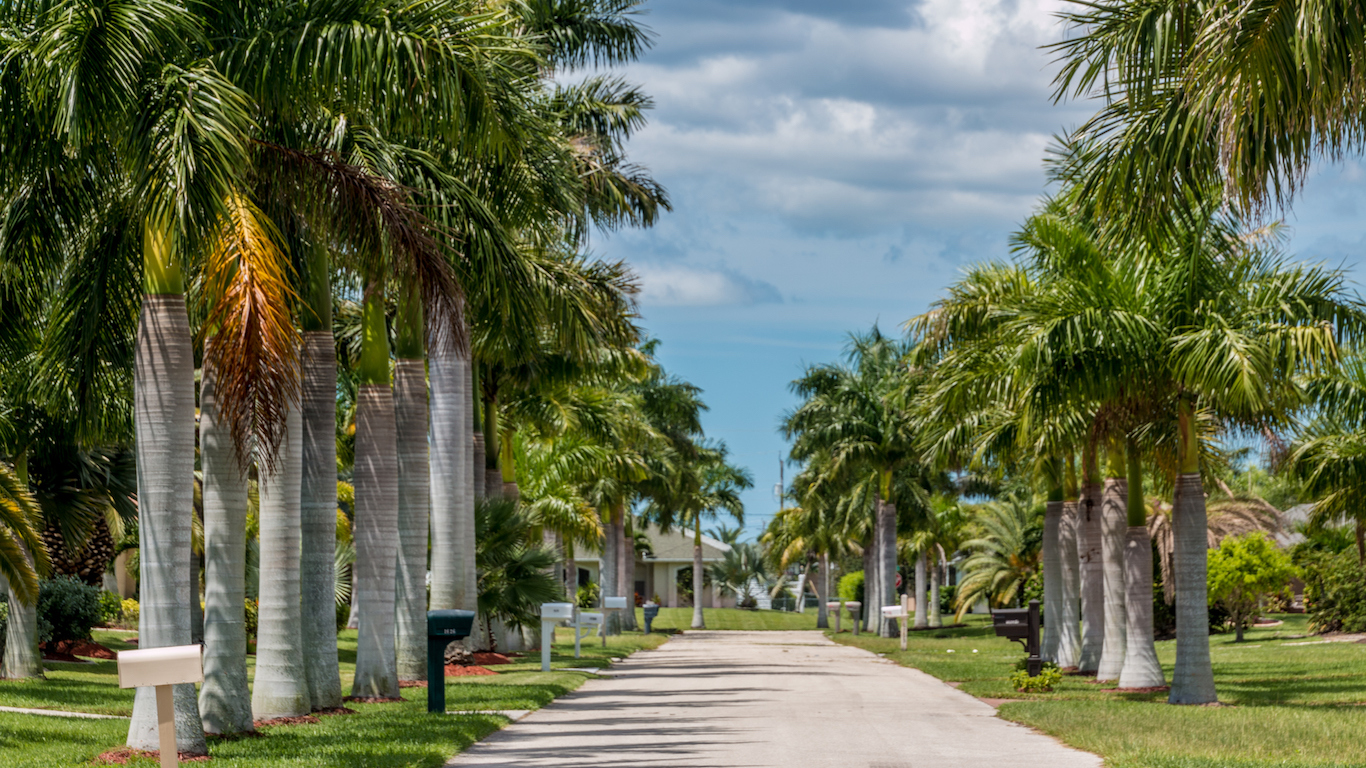
14. Cape Coral, Florida
> Violent crimes per 100,000: 116.8
> 2015 murders: 0
> Poverty rate: 13.7%
> Unemployment rate: 5.1%
With just 117 violent crimes reported per 100,000 residents in 2015, Cape Coral is the safest city in Florida and one of the safest in the country. Crime is also steadily declining in the area. Even as the Cape Coral population increased by more than 5,000 residents in 2015, the number of reported violent crimes fell by 16.1% — one of the best improvements in the country. The number of property crimes also fell significantly last year.
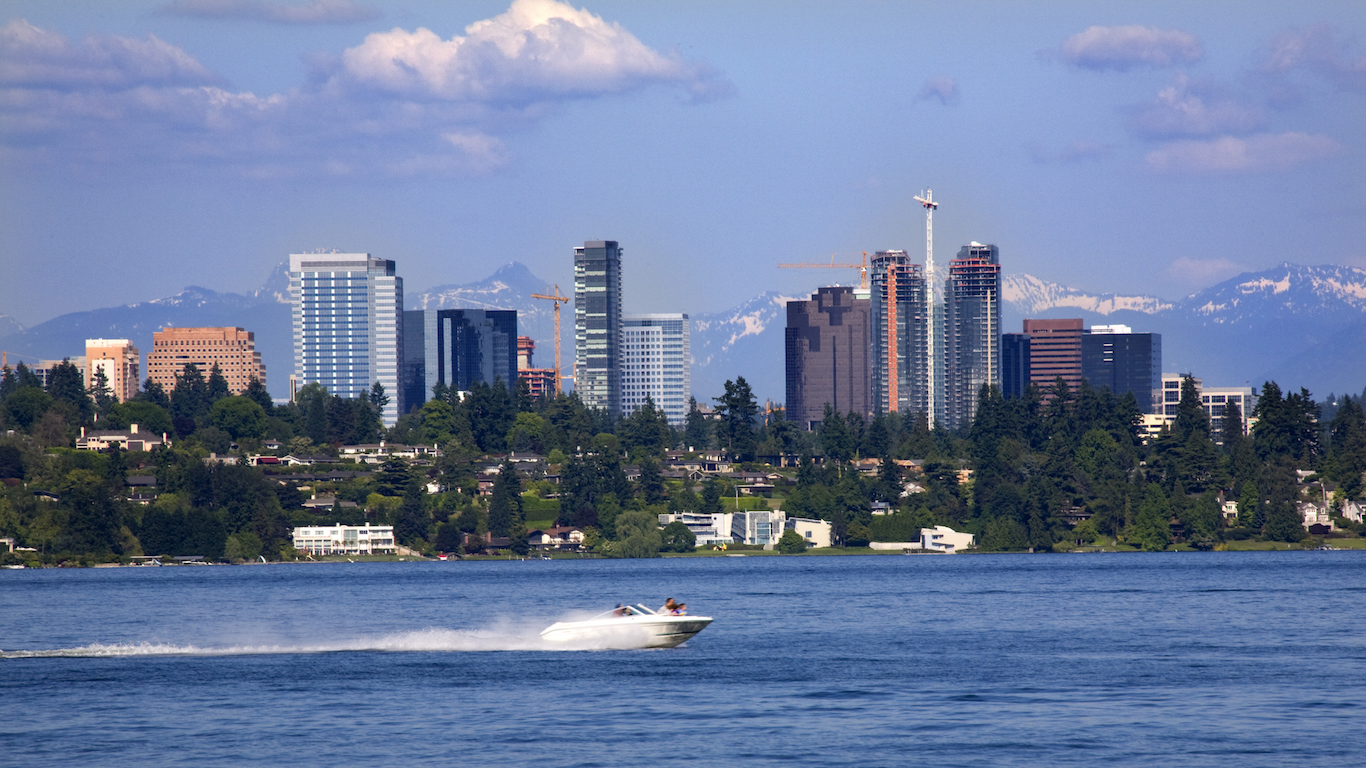
13. Bellevue, Washington
> Violent crimes per 100,000: 109.7
> 2015 murders: 2
> Poverty rate: 8.0%
> Unemployment rate: 4.0%
Just 110 violent crimes were reported per 100,000 Bellevue residents in 2015, the lowest rate in Washington and one of the lowest nationwide. While Bellevue has a fairly low violent crime rate, it has a relatively high property crime rate. The area’s property crime rate of 3,126 incidents — of burglary, larceny, motor vehicle theft, and arson — per 100,000 residents is higher than the national rate by about 600 incidents.
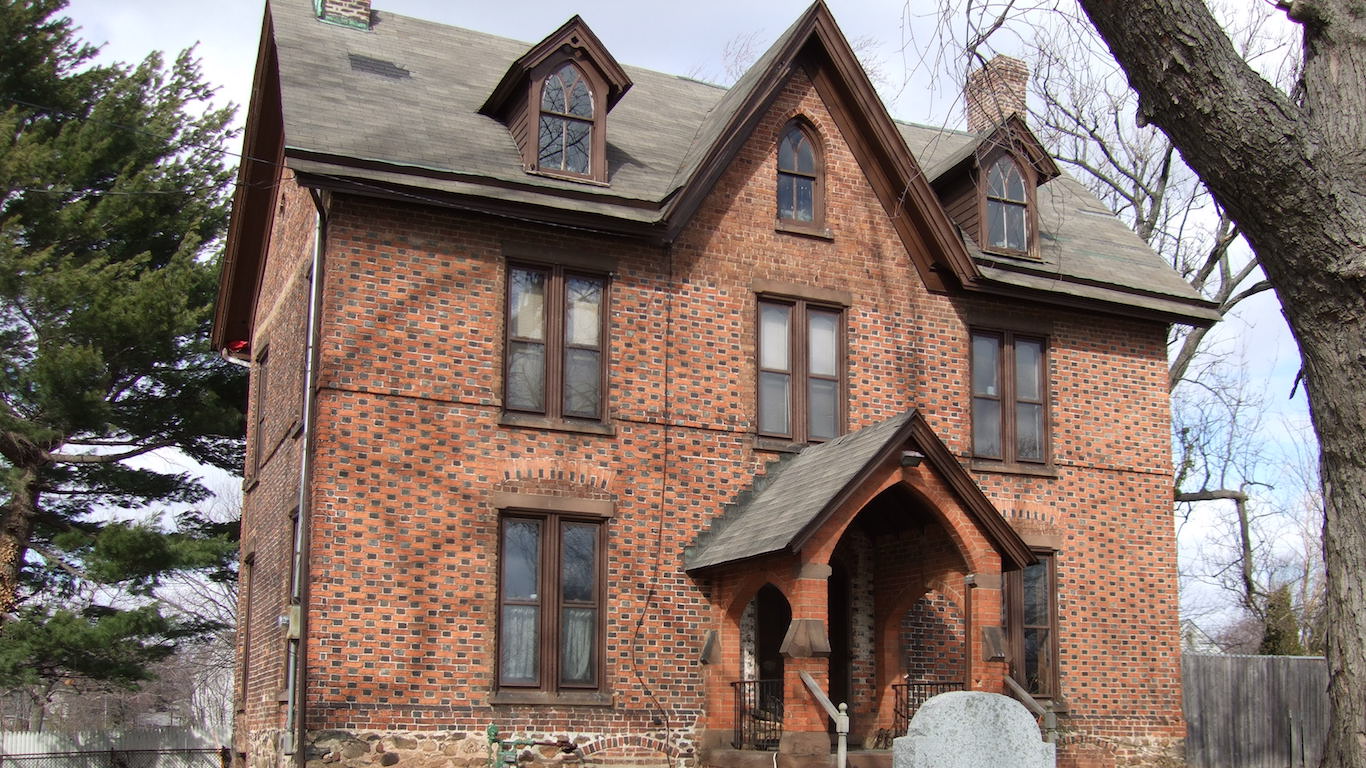
12. Woodbridge, New Jersey
> Violent crimes per 100,000: 109.0
> 2015 murders: 1
> Poverty rate: 6.1%
> Unemployment rate: 0.0%
There were just 109 violent crimes reported per 100,000 residents in Woodbridge in 2015, among the lowest per capita of any U.S. city. Crime tends to be less prevalent in more affluent areas, and Woodbridge is no exception. The typical household in the city earns $86,506 annually, far more than the $53,482 the typical household earns nationwide. Similarly, just 6.1% of Woodbridge residents live in poverty, the sixth smallest share of any city.
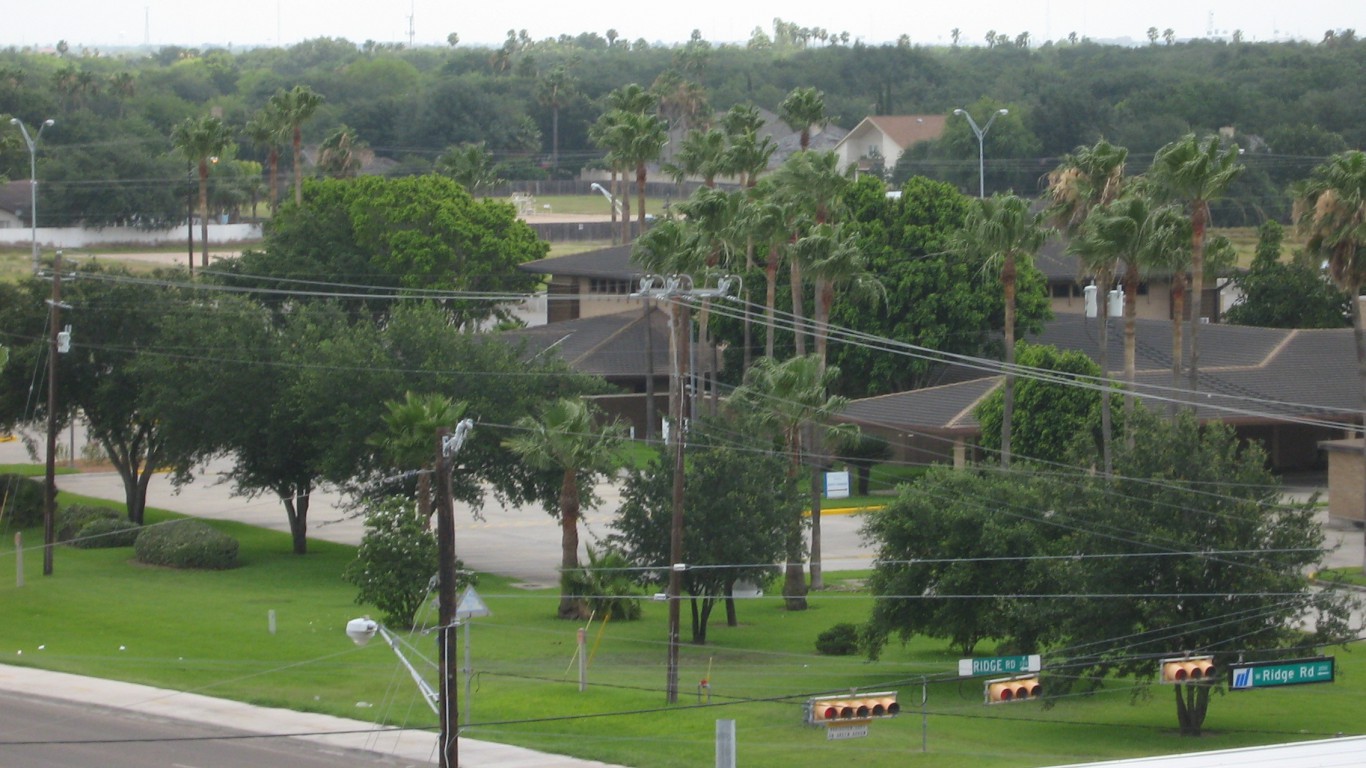
11. McAllen, Texas
> Violent crimes per 100,000: 108.1
> 2015 murders: 2
> Poverty rate: 26.4%
> Unemployment rate: 5.0%
One of the poorest cities in the country, McAllen’s poverty rate of 26.4% is far more than the national poverty rate of 15.6%. While crime tends to be more prevalent in less wealthy areas, McAllen is one of the safest cities in the country. Just 108 violent crimes were reported per 100,000 residents in 2015, less than in all but 10 cities. One reason for the low crime rate may be McAllen’s location along the U.S.-Mexico border. Many government agencies — including Border Patrol and U.S. Immigration and Customs Enforcement among others — help police enforce the law in border towns such as McAllen. Perhaps due to the additional enforcement, border towns are often safer than most large U.S. cities.
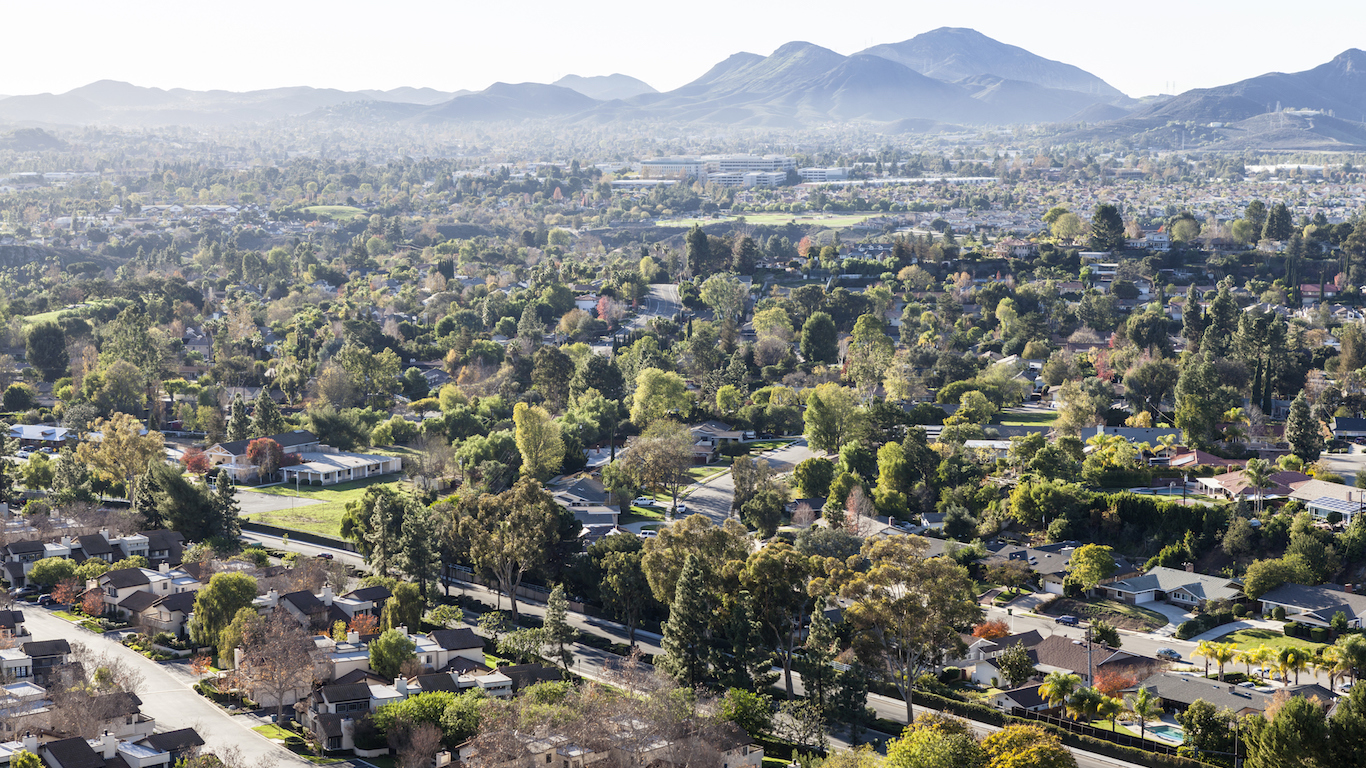
10. Thousand Oaks, California
> Violent crimes per 100,000: 104.6
> 2015 murders: 0
> Poverty rate: 7.0%
> Unemployment rate: 5.5%
Crime is often less prevalent in high income areas, and the affluence of Thousand Oaks may partially explain the low level of violence in the city. The typical household in the city earns $99,115 a year, the fifth highest median income of any major U.S. city. Also, just 7.0% of residents live in poverty, less than half the 15.6% national poverty rate. Living in economically disadvantaged areas can strain relationships, lead to financial distress, and encourage illegal behavior. The absence of these factors has likely helped reduce violence in Thousand Oaks.
[in-text-ad]
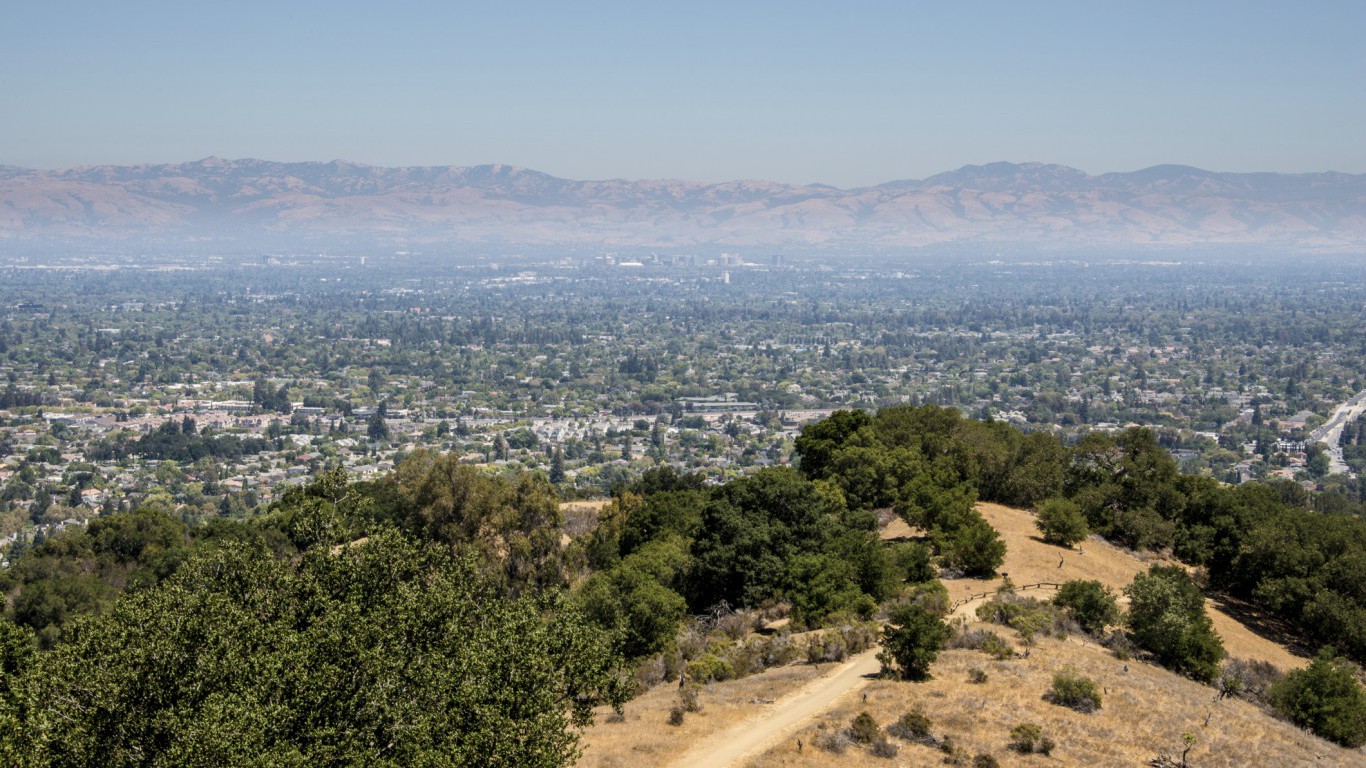
9. Sunnyvale, California
> Violent crimes per 100,000: 103.6
> 2015 murders: 1
> Poverty rate: 7.9%
> Unemployment rate: 3.7%
Sunnyvale is one of many California cities among the safest in the country. There were just 104 violent crimes per 100,000 Sunnyvale residents in 2015, among the lowest of any U.S. city. Crime is less common in wealthy areas where residents have access to a healthy job market. The typical Sunnyvale household earns $103,257 annually, nearly double the national median income. Similarly, just 3.7% of the Sunnyvale workforce is unemployed, one of the lower unemployment rates nationwide.
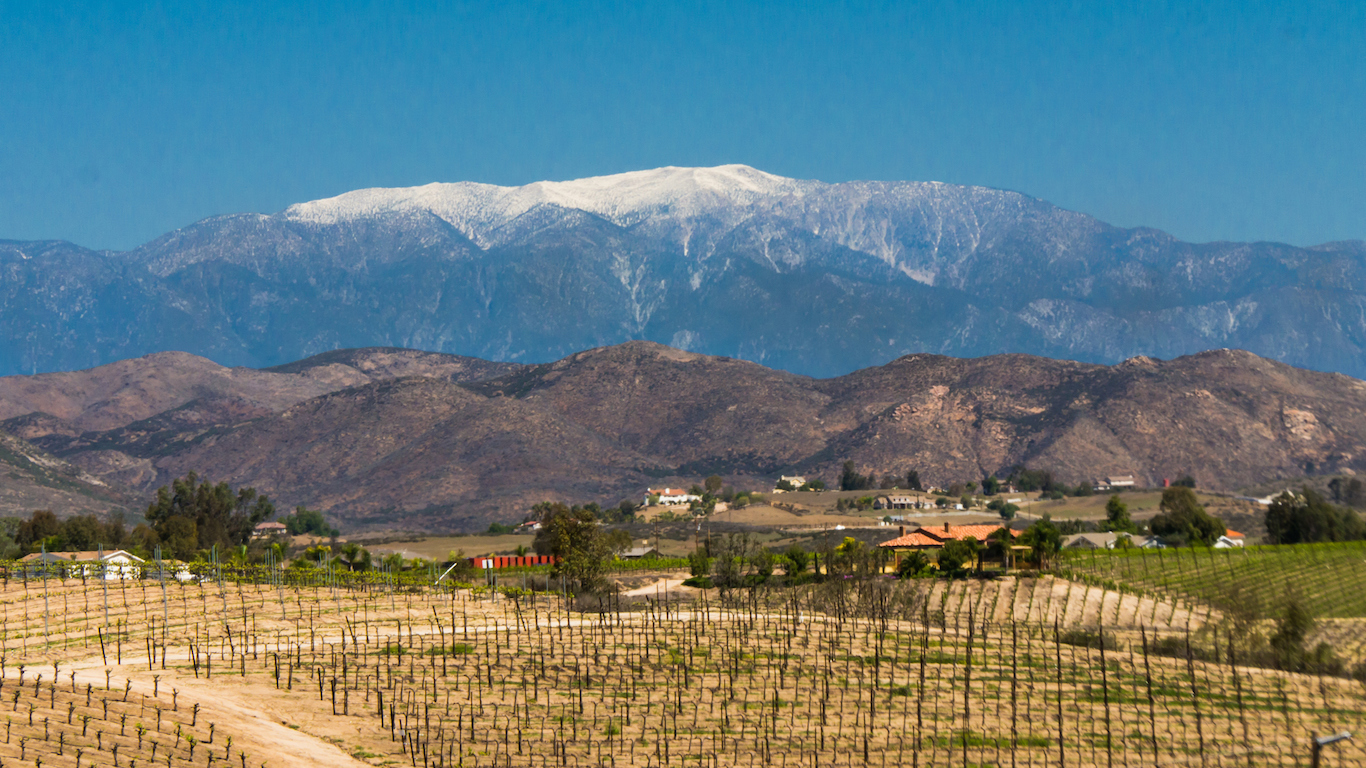
8. Temecula, California
> Violent crimes per 100,000: 102.1
> 2015 murders: 1
> Poverty rate: 8.2%
> Unemployment rate: 4.8%
While Temecula is one of the safest places in the country, crime is on the rise. The number of violent crimes rose by 14% between last year, one of the sharper increases of any U.S. city. Like in many cities in California, the police department in Temecula has attributed the uptick in crime to California’s recent reductions of prison sentences for certain drug offenders. The number of property crimes — burglary, larceny, motor vehicle theft, and arson — in Temecula increased substantially in 2015.
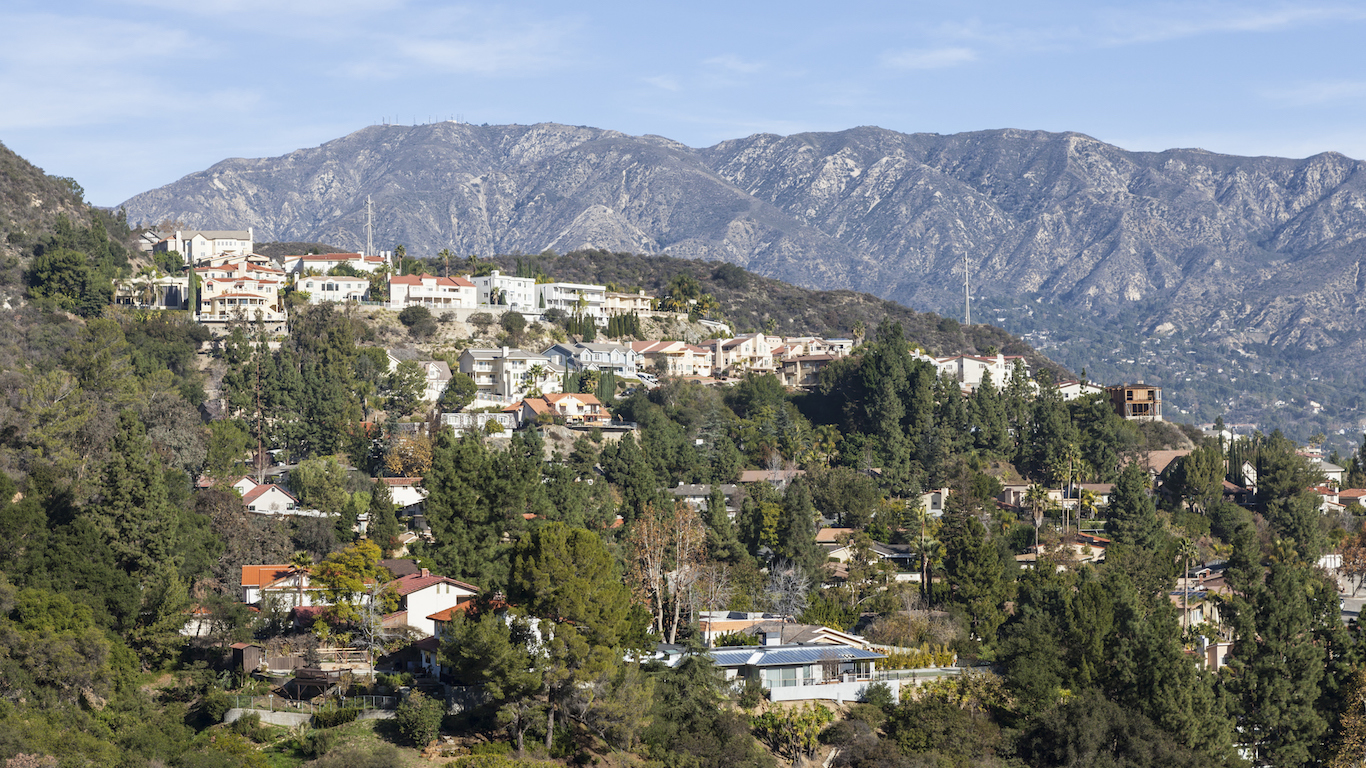
7. Glendale, California
> Violent crimes per 100,000: 96.4
> 2015 murders: 5
> Poverty rate: 14.7%
> Unemployment rate: 6.5%
There were fewer than 100 violent crimes per 100,000 Glendale residents in 2015, the seventh lowest rate of any city in the country. At 1,737 incidents per 100,000 residents, Glendale’s property crime rate is also relatively low. By contrast, there were 2,487 property crimes reporter per 100,000 people nationwide. While crime is often less common in wealthy areas with favorable economic conditions like low unemployment, Glendale’s population is actually slightly less affluent than is common in America’s safest cities. The median annual household income in Glendale of $52,451 is about $1,000 lower than the national figure. Similarly, Glendale’s 6.5% unemployment rate is slightly higher than the national unemployment rate.
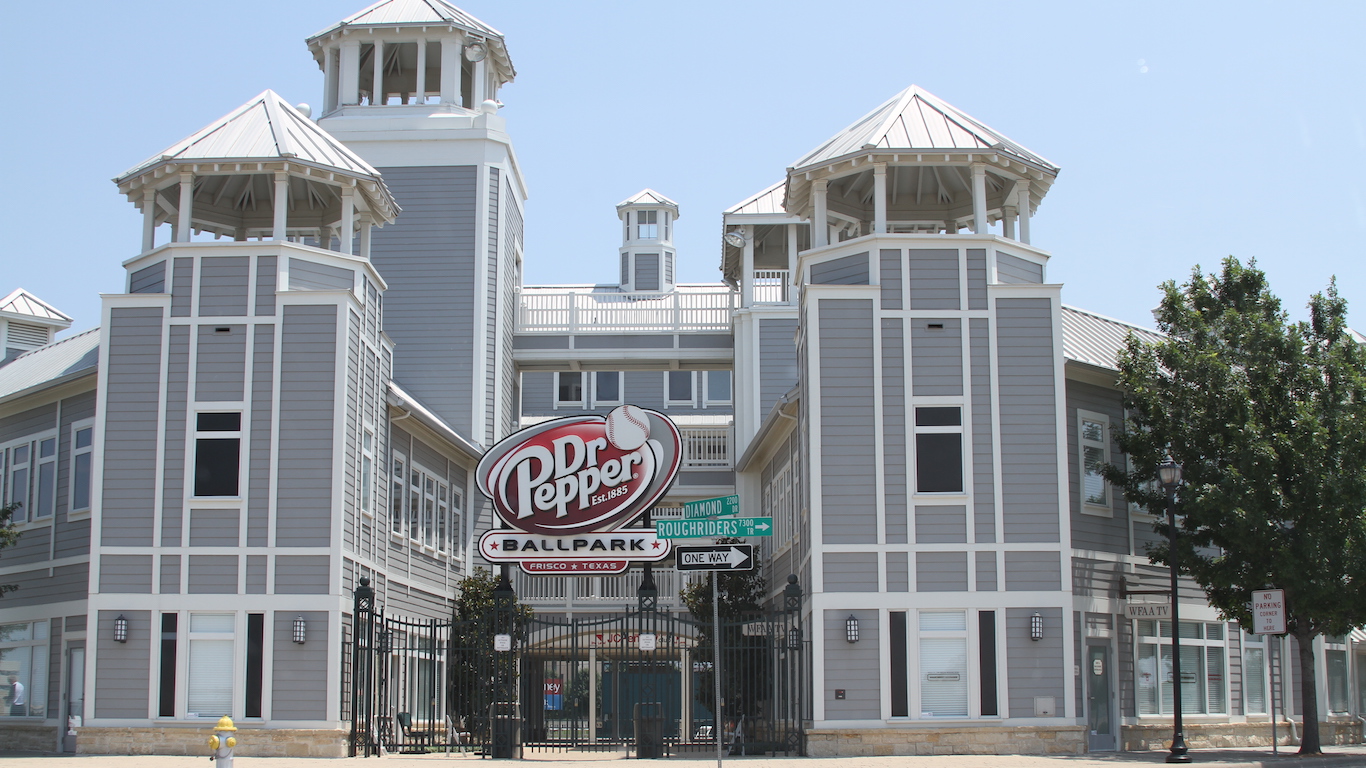
6. Frisco, Texas
> Violent crimes per 100,000: 91.0
> 2015 murders: 2
> Poverty rate: 4.2%
> Unemployment rate: 2.9%
Just 91 violent crimes were reported per 100,000 residents in Frisco in 2015, less than in all but five U.S. cities. Crime is often less prevalent in wealthy areas with low unemployment, as fewer crimes are committed out of financial necessity, more lawful opportunities tend to be available, and the financial distress that can lead to violence is less common. In Frisco, the typical household earns $112,155 annually, the highest median household income in the country. Also, the 2.9% unemployment rate is tied for the fourth lowest of any city.

5. Naperville, Illinois
> Violent crimes per 100,000: 87.0
> 2015 murders: 0
> Poverty rate: 4.3%
> Unemployment rate: 4.5%
There is often less crime in wealthy areas with low poverty, and Naperville is no exception. The typical Naperville household earns $109,512 annually, the second highest median income of any large U.S. city. Similarly, the 4.3% poverty rate is the second lowest. The drivers of crime levels appear to be very localized. While suburban Naperville is one of the safest cities in the country, neighboring Chicago is one of the most dangerous. There were 478 reported murders or instances of nonnegligent manslaughter in Chicago in 2015, more than in any other city in the country.
[in-text-ad]

4. Gilbert, Arizona
> Violent crimes per 100,000: 71.6
> 2015 murders: 2
> Poverty rate: 6.8%
> Unemployment rate: 4.2%
Five years ago 84 violent crimes were reported per 100,000 residents in Gilbert. Even then, the city was among the safest, and the crime rate has fallen since then. Just 72 violent crimes were reported per 100,000 Gilbert residents in 2015, the fourth lowest rate of any large U.S. city. According to Arizona’s local CBS channel, Gilbert’s police attribute the drop in crime to its use of data in its recently implemented crime tracking system.
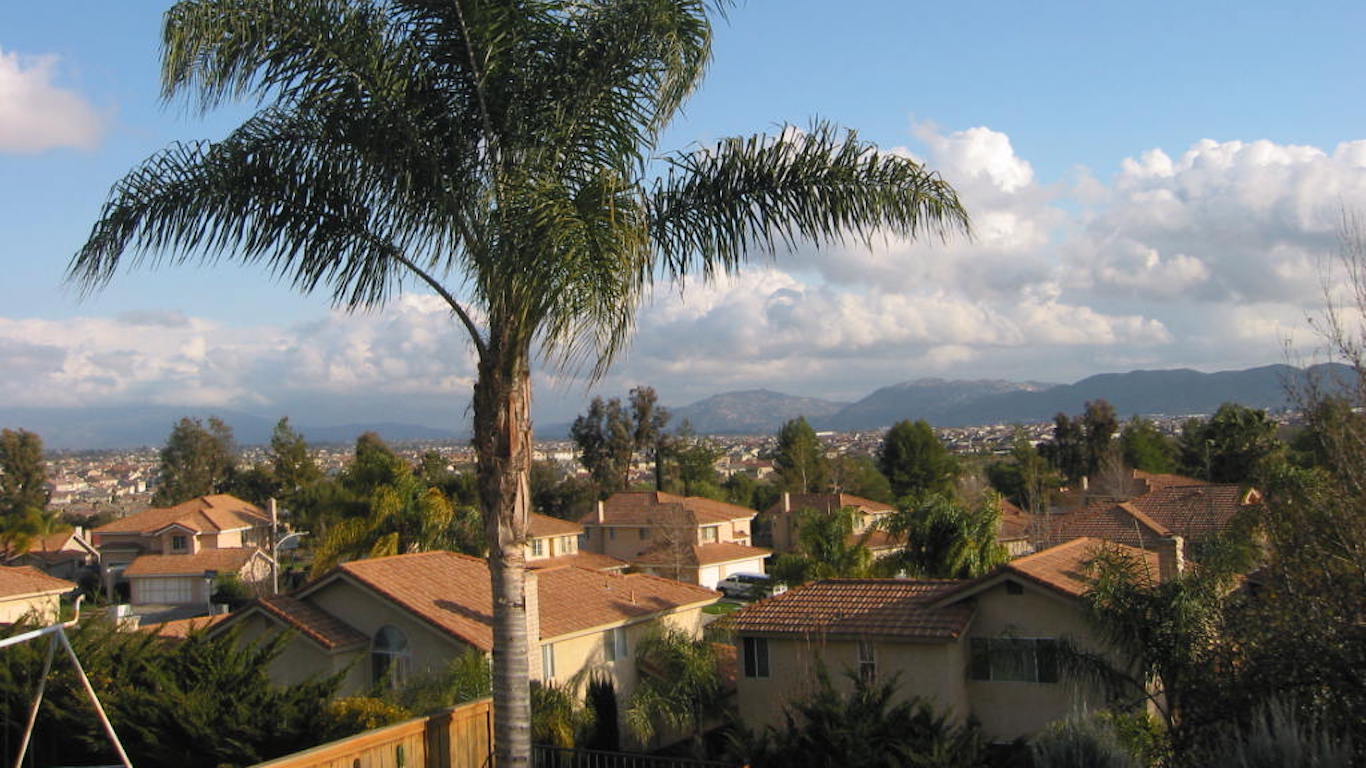
3. Murrieta, California
> Violent crimes per 100,000: 63.0
> 2015 murders: 0
> Poverty rate: 7.9%
> Unemployment rate: 5.4%
Murrieta residents reported just 63 crimes per 100,000 people in 2015, the third lowest violent crime rate of any city. There were also just 1,553 property crimes per 100,000 residents, far lower than the national figure. While the Murrieta violent crime rate remained unchanged compared to 2014, however, the property crime rate increased substantially. Like many cities in California, the Murrieta police department attributes the spike in property crime to a state law passed in 2014, which reduced prison sentences for certain drug offenders. The 16.6% increase in the number of property crimes in Murrieta is in stark contrast with the 2.6% nationwide decline.
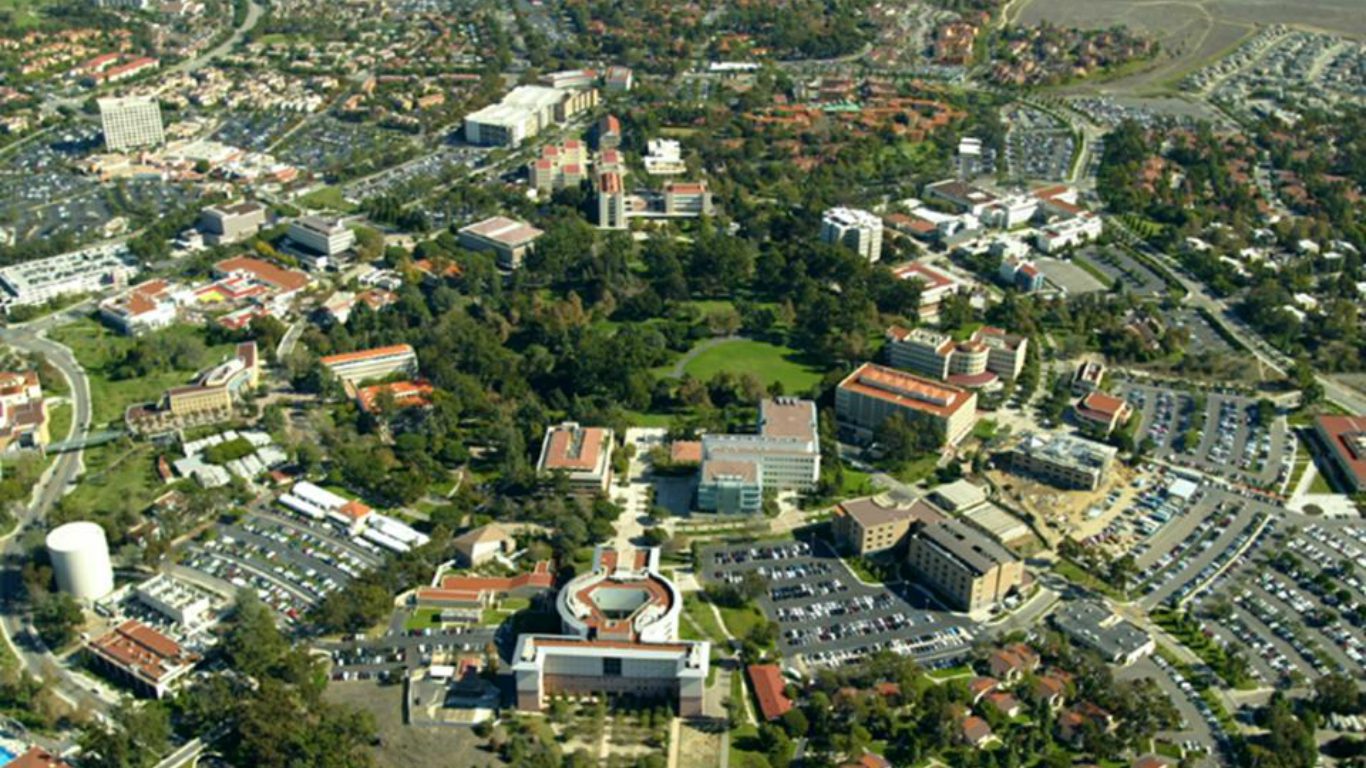
2. Irvine, California
> Violent crimes per 100,000: 55.8
> 2015 murders: 2
> Poverty rate: 12.4%
> Unemployment rate: 3.3%
Nearly two-thirds of adults living in Irvine have at least a bachelor’s degree, one of the highest proportions of any city in the nation and a very strong indication of the prosperity that tends to accompany high educational attainment rates. In turn, such prosperity tends to help keep crime levels low. In relatively safe cities, there tend to be more lawful opportunities for residents, which reduces the likelihood of violence. With an unemployment rate of 3.3%, one of the lowest rates, Irvine workers have access to more jobs, for example.
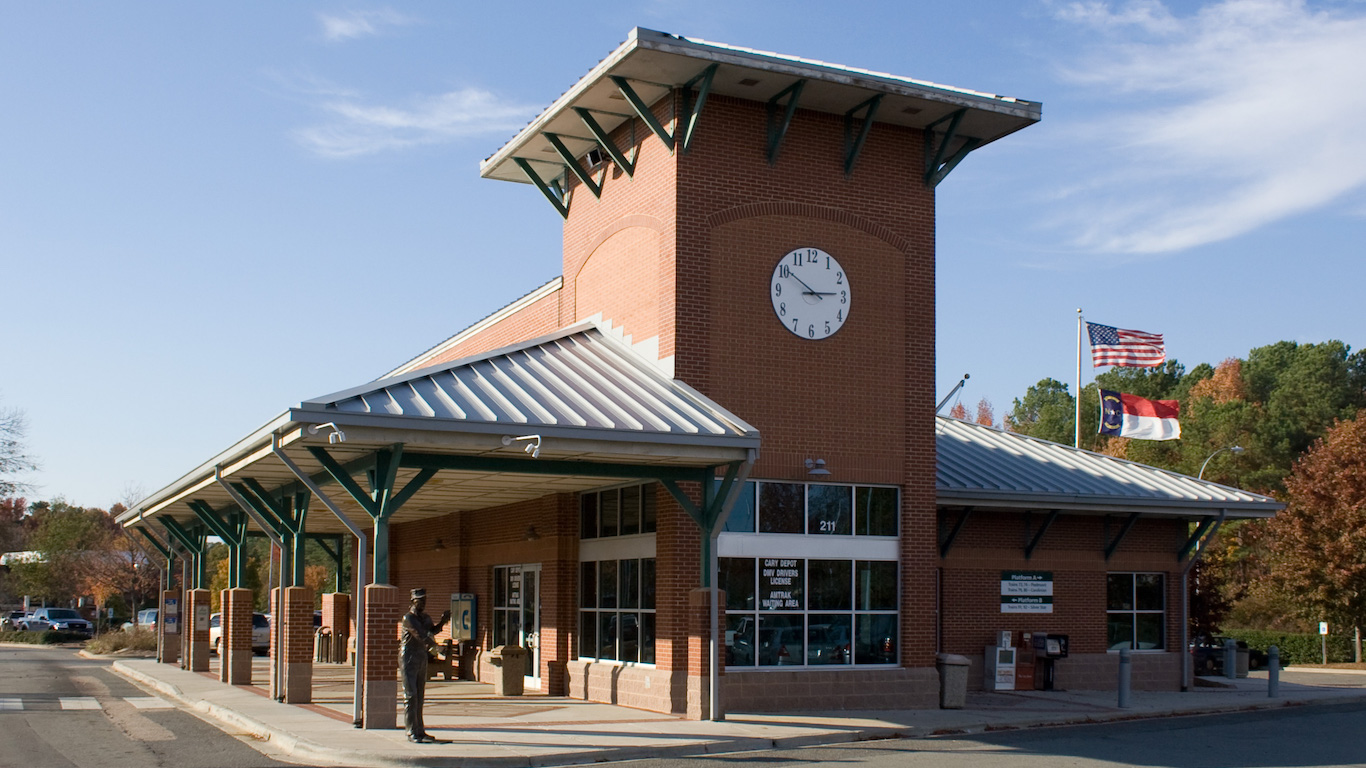
1. Cary, North Carolina
> Violent crimes per 100,000: 50.5
> 2015 murders: 5
> Poverty rate: 6.7%
> Unemployment rate: 3.8%
No city is safer than Cary, where just 51 violent incidents were reported last year for every 100,000 city residents — a fraction of the national violent crime rate of 373 per 100,000 people. Also, while violent crime is up across the nation, the number of incidents in Cary dropped by 17.3% last year.
In addition to safe neighborhoods, Cary residents enjoy high incomes, low poverty, and a healthy job market. The typical household earns $91,481 annually versus the national median of $53,482. The city’s poverty rate of 6.7% is less than half the national rate of 15.6%. And, 3.8% of the workforce is unemployed, well below the 2015 national jobless rate of 5.3%.
Click here to see the most dangerous cities in America.
It’s Your Money, Your Future—Own It (sponsor)
Retirement can be daunting, but it doesn’t need to be.
Imagine having an expert in your corner to help you with your financial goals. Someone to help you determine if you’re ahead, behind, or right on track. With SmartAsset, that’s not just a dream—it’s reality. This free tool connects you with pre-screened financial advisors who work in your best interests. It’s quick, it’s easy, so take the leap today and start planning smarter!
Don’t waste another minute; get started right here and help your retirement dreams become a retirement reality.
Thank you for reading! Have some feedback for us?
Contact the 24/7 Wall St. editorial team.
 24/7 Wall St.
24/7 Wall St.



